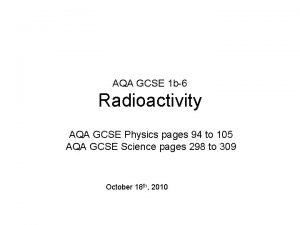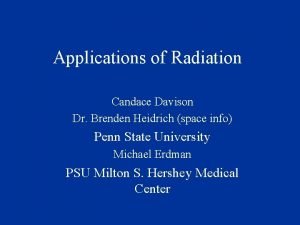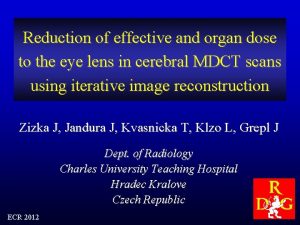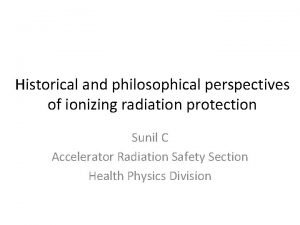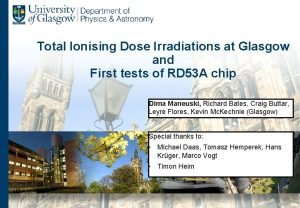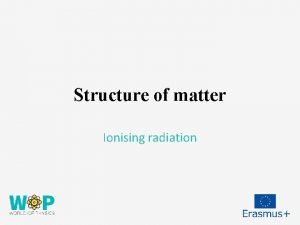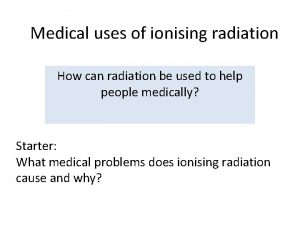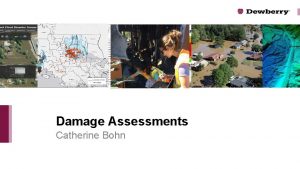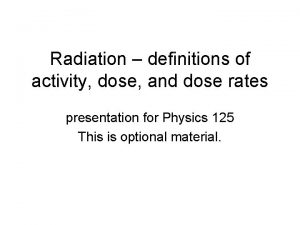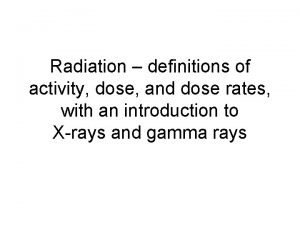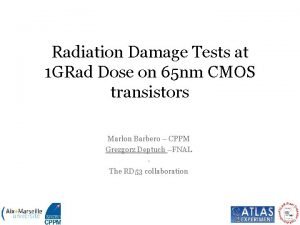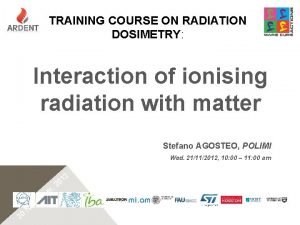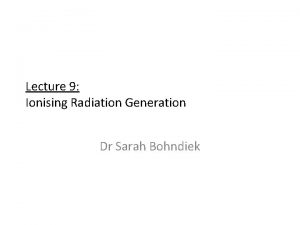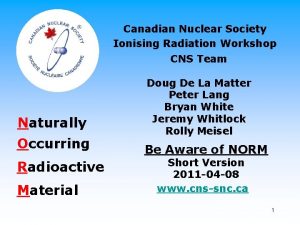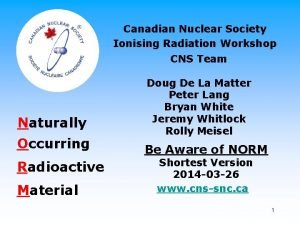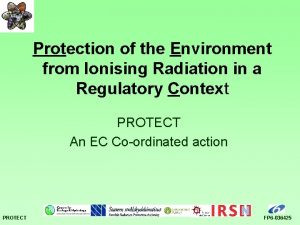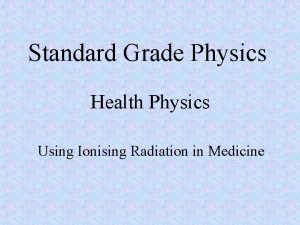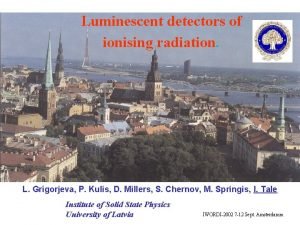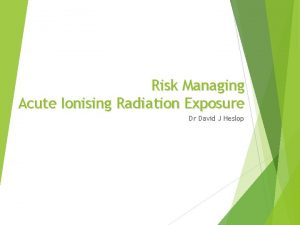Total ionising dose radiation damage studies of the






















- Slides: 22

Total ionising dose radiation damage studies of the RD 53 A chip for the ATLAS and CMS upgrades Dima Maneuski R. Bates, C. Buttar (Uof. G) J. Christiansen, L. M. Jara Casas (CERN) A. Dimitrievska, M. Garcia-Sciveres, T. Heim (LBNL) For the RD 53 collaboration

Presentation plan • Motivation for ATLAS and CMS upgrades • Requirements for HL-LHC experiments • RD 53 collaboration • RD 53 A chip • Testing environment • Testing protocols • RD 53 A measurements • Conclusions and future plans 8 July 2019 Dima Maneuski, IWORID 2019, Κολυμπάρι, Κρήτη 1

ATLAS Inner Tracker (ITk) Motivation for upgrade • Need same or better performance as the current detector • Higher luminosity • Harsher radiation environment Detector layout considerations • η coverage increased from 2. 5 to 4 • 5 pixel barrel layers and 5 pixel rings • 10’ 000 modules with 12 -14 m 2 of pixel detectors 8 July 2019 Dima Maneuski, IWORID 2019, Κολυμπάρι, Κρήτη 2

ITk pixel detector Requirements for HL-LHC experiments • Small pixels: 50 x 50 mm (25 x 100 mm is also under study) • Large chips: 2 x 2 cm • Pixel hit rate: up to 3 GHz/cm 2 • Rad tolerance: up to 1 Grad, 1016 n/cm 2 • Data rates: up to 5. 12 Gbit/s per chip • Trigger: up to 1 MHz with 12. 8 ms latency • Powering: serial powering scheme RD 53 collaboration 8 July 2019 Dima Maneuski, IWORID 2019, Κολυμπάρι, Κρήτη 3

RD 53 collaboration An ATLAS – CMS collaboration • Joint effort between ATLAS and CMS communities • Goals: • Understand radiation effects in the 65 nm fabrication process • (Bari, Milano, Padova, Bergamo-Pavia, Pisa, Perugia, Torino) Build a shared rad-hard IP library • Develop tools and methodologies to design large scale mixed signal chips • Fabricate and characterise full size prototype chips to make informed decision on the final pixel chips for ATLAS and CMS • Conformed by 24 institutes • Produced a prototype RD 53 A chip http: //rd 53. web. cern. ch 8 July 2019 Dima Maneuski, IWORID 2019, Κολυμπάρι, Κρήτη 4

Radiation damage studies Total Ionising Dose (TID) damage studies • RD 53 collaboration treats radiation damage as one of the IC design corners • RD 53 collaboration developed 200 MRad and 500 MRad simulation models to “predict” the circuit behaviour during design phase • RD 53 chips are designed to meet specifications at 500 MRads when operated in a controlled environment (-15 °C) • Extensive radiation campaigns have been carried out to qualify the 65 nm fabrication technology: • Prototypes of all IPs and Front-ends • Small scale demonstrators: 23 various test structures / chips • Lessons learned from the test structures were implemented in a prototype RD 53 A chip 8 July 2019 Dima Maneuski, IWORID 2019, Κολυμπάρι, Κρήτη 5

RD 53 A chip Large scale IC demonstrator Property Value • Demonstrate technology suitability for HL-LHC upgrades Technology 65 nm CMOS Detect capacitance < 100 f. F Detector leakage < 10 n. A Detection threshold < 600 e- Noise hits < 10 e-6 • Test digital readout architectures Charge resolution > 4 To. T • Basis for final ATLAS and CMS chips Triger rate Max 1 MHz Readout rate Up to 5. 12 Gbit/s Rad tolerance 500 MRad @ -15°C Power @ max rate < 1 W / cm 2 Temperature range -40 - +40 °C • Test analogue Front End design variations Full specification see RD 53 manual: https: //cds. cern. ch/record/2287593 8 July 2019 Dima Maneuski, IWORID 2019, Κολυμπάρι, Κρήτη 6

RD 53 A chip 12 mm RD 53 A chip functional floor plan 20 mm 8 July 2019 Dima Maneuski, IWORID 2019, Κολυμπάρι, Κρήτη 7

RD 53 A chip Front End flavours Schematic of the FEs see backup 8 July 2019 Dima Maneuski, IWORID 2019, Κολυμπάρι, Κρήτη 8

Testing environment X-ray irradiation facilities and testing environments • Need to uniformly cover the whole chip area (12 x 20 mm) • Need calibrated dose and stability in time (up to 4 weeks of irrad’s and tests at a time) • Irradiation and measurements to be done at ~ -20 ˚C or below. • Many instruments need automation to coherently take measurements (24/7 for weeks) • Ultimately, need to mimic real LHC environment as much as possible CERN xray, ATLAS pixel group 8 July 2019 University of Glasgow Dima Maneuski, IWORID 2019, Κολυμπάρι, Κρήτη University of Bonn 9

Testing protocols Infrastructure • Temperature control / monitoring • Humidity control / monitoring • Power supplies control / monitoring • Aux voltages / currents monitoring • Motion control / monitoring Chip characterisation L E A D • Analog, digital • Charge injection • Ring oscillators • Tuning • Temperature, radiation sensors, ADCs (results not show in this presentation) • All done every 1, 2, 5, 20, 50, … MRad • Irradiate few chips to 100, 200 … MRad 8 July 2019 DAQ Dima Maneuski, IWORID 2019, Κολυμπάρι, Κρήτη Infrastructure Motion control 10

RD 53 A measurements Power measurements Digital functionality … -25 ˚C • Serial powering is the baseline choice for ATLAS and CMS • Chip is operating after 1000 MRad • RD 53 A has two power domains (digital and analog), and can be powered in direct, LDO and Shunt. LDO modes (Shunt. LDO mode is to be used in the ITk) • Command decoder responds, the chip is configurable • No difference in Bunch Crossing ID and number of hits detected were seen after 1000 MRad • 8 July 2019 Dima Maneuski, IWORID 2019, Κολυμπάρι, Κρήτη After 1000 MRads * This graph up to 600 MRads Pre-irradiation No significant changes in power consumption was seen during irradiation up to 1000 MRad in direct power mode (only changes related to the different configuration of the chip) 11

RD 53 A measurements Upcoming plots explained µ σ (injection voltage) Threshold distribution for enabled pixels 8 July 2019 Dima Maneuski, IWORID 2019, Κολυμπάρι, Κρήτη 12

RD 53 A measurements Threshold and noise distributions (Synchronous FE) Auto Zero-ing (AZ) duration in real experiment is about 3µs • Up to 100 MRad no significant change • At 500 MRad (chip spec. ) 13% drop • At 1000 MRad (lifetime of experiment) 25% drop 8 July 2019 • Up to 1000 MRads change up to 5% • Some of the changes can be recovered from by adjusting global DAC Dima Maneuski, IWORID 2019, Κολυμπάρι, Κρήτη 13

RD 53 A measurements Threshold and noise distributions (Linear FE) • Up to 10 MRad no significant change • Up to 100 MRad ~ 10% increase • At 500 MRad (chip spec. ) ~35% increase • At 1000 MRad (lifetime of experiment) ~38% increase 8 July 2019 • Up to 100 MRad no significant change • Up 500 MRad ~6 -8% drop • Up to 1000 MRads ~ 10 -12% drop • Some of the changes can be recovered from by adjusting global DAC Dima Maneuski, IWORID 2019, Κολυμπάρι, Κρήτη 14

RD 53 A measurements Threshold and noise distributions (Differential FE) • Up to 5 MRad Thr increase with tuning at each dose • Up to 100 MRad no significant change • At 500 MRad (chip spec. ) ~12% drop • At 1000 MRad (lifetime of experiment) ~16% drop 8 July 2019 • Up to 1000 MRads up to 10% change • Some of the changes can be recovered from by adjusting global DAC Dima Maneuski, IWORID 2019, Κολυμπάρι, Κρήτη 15

RD 53 A measurements Ring oscillator measurements Global enable pulse Ring oscillator output • Eight ring oscillators included in RD 53 A for radiation testing, built with different logic cells: CLK, INV, NAND, NOR • Ring oscillators placed in the bottom right corner of the chip • Each oscillator drives a 12 -bit counter, which is enabled for a known amount of time set by configuration • Frequency of the oscillator can be calculated from known length of the Global Enabling Pulse and the number of counts obtained in the counter. 8 July 2019 Dima Maneuski, IWORID 2019, Κολυμπάρι, Κρήτη 16

RD 53 A measurements Ring oscillator measurements cont’d • Results of performance of the ring oscillators in RD 53 A with respect to a test chip in a similar range: RD 53 A degradation in the range of 72% to 87%, DRAD test chip in the range 68% to 78% 8 July 2019 Dima Maneuski, IWORID 2019, Κολυμπάρι, Κρήτη 17

RD 53 A measurements TID irradiations at different dose rates • From single transistor irradiation experiments it is known that radiation damage is worse with low dose rate compared to high dose rate for the same integrated dose • New setup with Kr-85 gas with low dose rate at LBNL (~0. 025 MRad/h) • So far after 100 MRads of total dose the difference is up to 3 times, experiments on going • Also setups are now in operation at ETH Zurich and Zagreb (Co 60) 8 July 2019 Dima Maneuski, IWORID 2019, Κολυμπάρι, Κρήτη 18

Conclusions and future plans • RD 53 collaboration studies radiation effects in electronics for the design and production of the pixel readout chips • RD 53 collaboration produced a prototype RD 53 A chip to demonstrated technology feasibility to address ATLAS and CMS needs for the Front End chip • Total Ionising Dose radiation test results with the RD 53 A prototype chip are very promising, showing good performance after high radiation doses Plans • Study systematically TID rate dependency • Include more tests at each irradiation point • RD 53 B chip is expected to arrive late 2019 8 July 2019 Dima Maneuski, IWORID 2019, Κολυμπάρι, Κρήτη 19

BACKUP SLIDES 8 July 2019 Dima Maneuski, IWORID 2019, Κολυμπάρι, Κρήτη 20

RD 53 A chip Front End flavours • Telescopic cascode CSA (Krummenacher feedback) for linear Time Over Threshold (TOT) • • • Synchronous hit discriminator with track-and-latch comp Sync FE Synchronous FE Autozeroing circuitry for threshold trimming Variable 40 -to-320 MHz Fast TOT counter using a latch Linear FE Single stage amplification for minimum power dissipation • • High speed, low power current comparator Krummenacher feedback to comply with the expected large increase in the detector leakage current Lin FE • • 4 -bit local DAC for threshold tuning DAC Differential FE Continuous reset integrator first stage with DC-coupled pre-comparator stage Two-stage open loop, fully differential input comparator Leakage current compensation like in FE-14 (ATLAS IBL FE chip) Threshold adjusting with two per pixel 5 -bit DACs Common for all FEs • • Diff FE • • Low-noise, low-power, fast, small Threshold adjusting with global 10 -bit DAC 8 July 2019 Dima Maneuski, IWORID 2019, Κολυμπάρι, Κρήτη 21
 Gamma cameras bbc bitesize
Gamma cameras bbc bitesize Radiation dose limits
Radiation dose limits Radiation dose limits
Radiation dose limits Radiation dose limits chart
Radiation dose limits chart Radiation dose limits for workers and public pdf
Radiation dose limits for workers and public pdf Paradigm shift from women studies to gender studies
Paradigm shift from women studies to gender studies Total revenues minus total costs equals
Total revenues minus total costs equals Ciclo de servicio de una aerolinea
Ciclo de servicio de una aerolinea Total revenue minus total expenses
Total revenue minus total expenses Total revenues minus total costs equals
Total revenues minus total costs equals Total revenues minus total costs equals
Total revenues minus total costs equals Diễn thế sinh thái là
Diễn thế sinh thái là Frameset trong html5
Frameset trong html5 V cc cc
V cc cc Sơ đồ cơ thể người
Sơ đồ cơ thể người Làm thế nào để 102-1=99
Làm thế nào để 102-1=99 Bài hát chúa yêu trần thế alleluia
Bài hát chúa yêu trần thế alleluia đại từ thay thế
đại từ thay thế Vẽ hình chiếu vuông góc của vật thể sau
Vẽ hình chiếu vuông góc của vật thể sau Quá trình desamine hóa có thể tạo ra
Quá trình desamine hóa có thể tạo ra ưu thế lai là gì
ưu thế lai là gì Công thức tính thế năng
Công thức tính thế năng Các loại đột biến cấu trúc nhiễm sắc thể
Các loại đột biến cấu trúc nhiễm sắc thể
